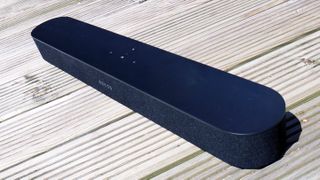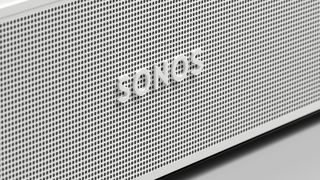Sonos Beam (Gen 2) vs Sonos Beam: what’s new with the pint-sized soundbar?
Sonos’ smallest soundbar has been given a hefty upgrade

We’ve been recommending the Sonos Beam to anyone on the market for a compact soundbar offering excellent connectivity for some time – but now that the audio company has announced the Sonos Beam (Gen 2), you may be wondering which soundbar is best for you.
From the outside, the Sonos Beam (Gen 2) looks similar to its predecessor, which makes it difficult to determine exactly what’s changed. In fact, the acoustic architecture of both soundbars is exactly the same.
However, there’s one big difference between the two generations of Beam. The Sonos Beam (Gen 2) brings Dolby Atmos immersive audio to the mini soundbar for the first time, and that could be a game-changer if you want to recreate the feel of a cinema at home.
Not surprisingly, the second-gen Sonos Beam has also seen a small price hike – and now that the original Beam has been usurped, we’re starting to see that model discounted. The level of discount is only likely to increase as we get closer to Black Friday 2021.
So, should you save some money and opt for the original model of Beam, or choose the Dolby Atmos-touting second-generation of Sonos’ smallest soundbar? We haven’t had the opportunity to test the Beam (Gen 2) just yet, but we’ve taken an in-depth look at all the new specs and features to help you make the right decision.

Sonos Beam (Gen 2) vs Sonos Beam: price and availability
The new Sonos Beam (Gen 2) will be available to buy from October 5 for $449 / £449 / $699 (although it is available to preorder now). This makes it more expensive than the original at launch, which cost $399 / £339 / AU$599.
We’ve already started to see prices for the original Sonos Beam come down, and you can almost guarantee that it will be discounted heavily over Black Friday 2021 – if stocks last, that is. The first-gen Beam has been officially discontinued, so you should act fast if you have your heart set on it.
Get daily insight, inspiration and deals in your inbox
Get the hottest deals available in your inbox plus news, reviews, opinion, analysis and more from the TechRadar team.
Weirdly, we’re not confident that the price of the second-gen Sonos Beam won’t change in the future. Sonos recently announced a price hike for a number of its products, stating that it evaluates pricing on a "market-by-market" basis. One of the biggest price increases was to the company’s other soundbar, the Sonos Arc, which is now $100 / £100 / AU$100 more expensive than before. That doesn’t exactly bode well for the new Beam.
Saying that, Sonos hasn’t made any suggestion that the Sonos Beam (Gen 2) will see a price increase any time soon – just be aware that the company’s prices aren’t set in stone.
Design
The design of the Sonos Beam (Gen 2) and its predecessor is largely the same, although the company has made a couple of subtle tweaks.
Both soundbars are designed for smaller spaces, and at 2.72 x 25.63 x 3.94 inches (H x W x D), they should fit comfortably under most TVs. Both devices are also available in black and white color options, they can be wall-mounted, and are controllable via a touch-sensitive panel found along the top of the unit. You also have the option of the Sonos S2 app, your TV remote, AirPlay 2, or using the built-in Google Assistant and Alexa voice assistants to control your music playback and other settings.
The only immediately discernible difference between the two is that Sonos has done away with the fabric grille on the original Beam, swapping it for a polycarbonate (or plastic, if you prefer) front.
The plastic grille matches that of the Sonos Arc – and, as the company points out, it’s far easier to clean than dust-attracting fabric. We asked Sonos whether the new grille brings any acoustic benefits, but the company told us it’s purely an aesthetic choice.
It certainly brings the soundbar into line with the rest of the Sonos ecosystem, since none of the other current-gen Sonos speakers feature fabric grilles.
Around the back of the soundbar you’ll now find an HDMI eARC port, rather than the HDMI ARC on the original Beam (more on that later).

Audio performance
The biggest difference between the Sonos Beam (Gen 2) and the original on the audio front is that the new soundbar supports Dolby Atmos.
This cinematic sound technology arranges elements of a film soundtrack (or compatible music files) in a 3D sphere, which makes it feel as though the sound is coming at you from every angle.
‘True’ Dolby Atmos speakers and soundbars – such as the Sonos Arc – use upfiring tweeters to bounce sound off the ceiling and back down to your ears to give soundtracks a sense of height, but the Sonos Beam (Gen 2) does this virtually.
According to Sonos, the sense that the sound is surrounding you from every angle is achieved using “psychoacoustic techniques”, made possible by the new and improved speaker arrays. The second-gen Beam contains five arrays as opposed to the three found in the original Beam.
While we’re yet to test this for ourselves, virtual Atmos can be quite convincing – although you’ll probably get a better sense of height from the pricier and larger Sonos Arc.
Otherwise, the rest of the audio tech inside the Sonos Beam (Gen 2) is the same as before. You have five class-D amplifiers, one center tweeter, four elliptical midwoofers, and three passive radiators working together to deliver a powerful and balanced sound.
And that’s no bad thing. In our review of the original Sonos Beam, we were blown away by the richness and depth of the audio, despite the unit’s small size. With this in mind, you can certainly expect a clear and impactful sound from the new Beam, especially if you pair it with some Sonos One SL rear speakers and the Sonos Sub for a more complete home cinema setup.
Like all Sonos speakers, the new Beam uses Trueplay, a feature that calibrates the soundbar to your room’s dimensions. The Beam (Gen 2) also still comes with sound modes such as Speech Enhancement for clear dialogue and Night mode for when you don’t want to disturb your neighbors – and, you can tweak the EQ settings via the S2 app.

Connectivity
Like the original Sonos Beam, the Beam (Gen 2) comes with support for Alexa and Google Assistant, AirPlay 2, and Wi-Fi connectivity, as well as an Ethernet port for hardwiring the soundbar to your router.
As mentioned, you can hook both soundbars up to your existing Sonos system for a richer home theater setup, or for multi-room audio to fill your entire space with sound.
One new connectivity feature included with the Sonos Beam (Gen 2) is HDMI eARC compatibility, which the company says will bring a “richer, more immersive, and higher definition sound experience”. Compared to the HDMI ARC connectivity found on the original Beam, eARC can handle more advanced audio formats and deliver superior audio quality.
It’s a shame there’s no HDMI passthrough support, which would allow for 4K at 120Hz and even 8K at 60Hz passthrough – which in turn, would make the Beam ideal for 8K-supporting consoles such as the PS5 and the Xbox Series X.
Still, the new Beam will be able to cope with 32 channels of audio, and even eight-channel 24-bit/192kHz uncompressed 38Mbps data streams. In other words, as well as supporting Atmos, it can play hi-res audio files of your favorite songs.

Takeaway
While we can’t say for certain whether you should buy the Sonos Beam (Gen 2) before we’re able to test it for ourselves, if you want Dolby Atmos without paying for the Sonos Arc, the newer soundbar is your best bet.
You should also opt for the newer Beam if you want to play hi-res audio files through your soundbar.
However, if you’re on a budget and Atmos or hi-res music isn’t on your radar, the original Sonos Beam is still a fantastic choice – and Sonos tells us that it will continue to be supported by updates and bug fixes in the future.
You’ll need to act fast if you do want to buy the original Beam, though. There’s no telling when stock will run out, and it will probably be quite popular over Black Friday in November.
Not sold on Sonos? There are plenty of other brilliant soundbars out there. If you want Dolby Atmos compatibility, check out models such as the Samsung HW-Q950A and the Sony HT-X8500. On a strict budget? The Vizio SB362An-F6 is well worth a look, as is the Sony HT-MT300.
- Read our guide to the best soundbars under $200 / £200
Olivia was previously TechRadar's Senior Editor - Home Entertainment, covering everything from headphones to TVs. Based in London, she's a popular music graduate who worked in the music industry before finding her calling in journalism. She's previously been interviewed on BBC Radio 5 Live on the subject of multi-room audio, chaired panel discussions on diversity in music festival lineups, and her bylines include T3, Stereoboard, What to Watch, Top Ten Reviews, Creative Bloq, and Croco Magazine. Olivia now has a career in PR.

